| Sponsor |

|
Inline Automatic X-Ray Inspection: TruView™ Verus
TruView™ Verus is a high-resolution inline AXI system offering advanced 2D, 2.5D, and 3D imaging to detect defects in electronic assemblies with exceptional accuracy and speed.
Creative Electron
|
|
| Ask the Experts |
|
|
November 5, 2009 - Updated
November 2, 2009 - Originally Posted
What Is The Ideal HASL Thickness?
What is the ideal solder thickness for hot air solder leveled (HASL) lead free boards?
K. S. G.
|
| Expert Panel Responses |
The ideal thickness is to be thick enough for good solderability, yet thin (flat) enough for part placement. Because of the HASL process and surface tension of solder, smaller pads will have a greater amount of solder as compared to larger pads.
Due to this and coupled with lead free HASL having an inter-metallic two times that of leaded HASL a minimum thickness is more crucial in the lead free process than the tin/lead process.
It is difficult to spec in a certain thickness because of the process so we (Florida Cirtech) concentrate on a minimum thickness and not on a range. Our recommended minimum thickness would be 100 microinches as this should insure good solderability.
Mike Scimeca
President
FCT Assembly
Mike Scimeca created FCT Assembly after the purchase of Fine Line Stencil, Inc., and consists of two major operations: stencil manufacturing and the manufacturing of electronic assembly products such as solder paste, flux and solder bar.
|
|
Submit A Comment
|
Comments are reviewed prior to posting. You must include your full name to have your comments posted. We will not post your email address.
|
Free Newsletter Subscription
Circuitnet is built for professionals who bear the responsibility of looking ahead, imagining the future, and preparing for it.
Insert Your Email Address
|
| Sponsor |

|
Reliable Potting Resins, Every Time
Ensure consistent performance with our epoxy & polyurethane resins engineered for durability, fast cure times, and seamless processing. Learn More!
Epic Resins
|
|
|





